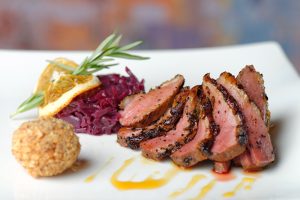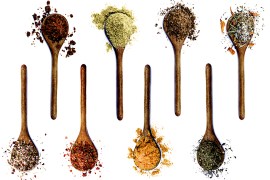Presenting at the best the Barbecue Dishes
Each of us has his own strengths that inevitably tends to highlight, side by side with his own weaknesses, with which it is necessary to learn to live together, seeking if it is not possible to eliminate them, at least to come down to pact. I have to make a confession: one of my weaknesses is the dish out of what I cook. I know, it is not the best one for a food operator, but unfortunately is the truth.
Let’s face it: I’m not used to overthrowing what I cook on a plate from a bucket, I just say there are other things about this world that I like more, that when I make them they come almost natural, they are “like flowers , they arise by theirself, are like dreams “to quote a famous italian song. But among these about me, certainly it ain’t the art of dish out. It just do not get into my blood, no way, I do not feel passionate about it. It is a fact that my dishes at the beginning were often good tasting than good looking and that I had to “educate” myself in this regard over time.
Premising that our world has strong and robust rural roots, firmly clinging to elements not particularly refined such as coal, wood and why not, a beer stacked with the lighter among friends and therefore there are several areas in which the best possible presentation is in my opinion on a simple steel tray covered with a sheet of butcher paper, it is true that the barbecue cooking is progressively decontesting and is rightly undergoing a process of gastronomic re-evaluation by embracing much more noble applications. In these contexts, dish out with particular grace and elegance becomes a real need and no longer a prank.
Over the years I have read everything about the subject to try to improve myself. For example, I found out that there are even seven classics techniques of dish out as teaching doctrine in Japan, and I have seen people summarizing in a book thirty years of experience in dishing out food but in the end the conclusion I came to is that it is precisely an art, in which it is almost impossible to grasp the creativity of the protagonists in overly rigid schemes, but which would be fundamental tools for those who do not possess their skills.
As it was said, however, those who want to improve at every costs must necessarily find their way to minimize the impact of their weaknesses. My way was to act in two directions: rationalize the procedures and reduce as far as possible the infinite variables.
On the one hand, I have built on the readings made and on the resulting experience, a sort of decalogue I attended to:
- I understand that dish out is a real project. So I study the recipe as first, the decorative elements and any contours, and I think before the realization how I will present it.
- In addition to tastes, contrasts help a lot in implantation: the chromatic ones, of course, but also in the consistences, which literally allow you to “build” the dish by superimposing or matching its elements. This is an element to be considered in the dish design.
- The dish is like a stage on which to decide where to spot the reflector: the more the heart of the preparation is attractive and the more I keep the decorations simple, the more it is sluggish and the more I need to “pull it out”. So if I come up with a beautiful salmon, with a nice inviting crostick and a bright orange color, I could accompany it with a white or green sauce on a simple strip that spins around. If, for example, I have some ember roasted onions with a dark, monotonous colors, close to brown I could show them in bloom shape and surround them with drops of two brightly colored contrasting sauces and possibly sprinkling crispy crusts over.
- I try to make geometric formulations with food where possible, because they are easier to associate for symmetry or asymmetry with the shape of the dishes they contain, which are usually either round or square / rectangular.
To this I add that between the myriad of possible alternatives I have chosen to use only the following tools:
- There are commercially available dishes of the most unlikely shapes and colors, which, in appearance, may seem like a help in dish out. Instead, I find them an obstacle because they always oblige me to adapt the composition to the ingredients of the recipe. So I choose a simple round dish, a squared and a rectangular one that allow me to do anything in practice. As colors, to the neutral white I add the black that with almost all kinds of meat works very well.
- I have a round box that like matrioska, contains one inside the other, some coppapasta of various sizes. They are useful not only to give shape to bulk food like rice or pasta but also to help me create shapes in the dish for decorations with sauces or other ingredients.
- I know that it may sound as trivial, but the thousand half-hour long drawings that I can do by pouring sauces with a squeezer are not worth the aesthetic sense and the convenience of pouring a spoonful in a corner and pulling it with a flat brush: simple, immediate and always anyway a perfect bed on which to place anything that has been reduced to mouthfuls.
- The aesthetic perfection of a thick sauce or a cream placed on the plate by pointing a sac a poche can not be replicated in any way. It is also very convenient, clean and fast to use.
Based on this, I formulated a small package of pre-established schemes to make explicit, with reference to barbecue preparations, useful to those who like me do not want to go crazy to invent each time who knows what artwork and preferring to dedicate their creativity to the recipe in itself. I hope it can be useful to you as well.
DISCLAIMER:
Before hurting other people's feelings, I would like to point out that with this post I have absolutely NO claim of exhausting the argument of dish out or doing any schooling in any way but just providing easy pre-established schemes to make it more intuitive to those who do not he particularly likes itThe Sequence

If I identify some elements preparation with different consistencies I can build a taste sequence that is repeated in the dish. I usually propose it by following the shape of the edge of a round dish, or by creating a line at the center of a round dish, side by side with parallel lines of accompanying sauce or even in a rectangular plate according to its shape. The sequence could also be continuous, forming a circle, again inside the round dish.
The Route
 It is a repetition of always equal elements. I use it mainly to present cuts of sliced meat portions, typically duck breast or steak, maybe a New York one, narrow and long but it can also be fine to repeat single bites, such as sushi in Japanese restaurants. It’s the classic case where I use the sauce lay with the brush, on which I like to rest the slices of meat. As dish the choice is almost obligatory towards the rectangular but I also happened to place it in a half a moon shape on the edge of a round dish and pouring in the middle some salsa drops.
It is a repetition of always equal elements. I use it mainly to present cuts of sliced meat portions, typically duck breast or steak, maybe a New York one, narrow and long but it can also be fine to repeat single bites, such as sushi in Japanese restaurants. It’s the classic case where I use the sauce lay with the brush, on which I like to rest the slices of meat. As dish the choice is almost obligatory towards the rectangular but I also happened to place it in a half a moon shape on the edge of a round dish and pouring in the middle some salsa drops.
The Bed

This is typically a creamy or quite dense sauce that should act as an intingle for the main course. Generally I use a coppapasta inside which the verse to give it a round shape that is symmetrical to that of the round dish I use for these cases. An example I’m used to is often a white beans cream, on which are placed in an orderly manner some scallops cooked on plate, the all decorated with dill twigs.
The Castle

This is essentially the classic elevation in plate layout. In this case, the game of consistency is crucial to allow a volume to be built. An example might be a puree of ember roasted beans, over which to be placed a slice of salmon with crisp skin on top, surmounted by a nest of soy sprouts, all surrounded by drops of traditional balsamic vinegar.
The Islands

It is basically about more bites belonging to the same dish but actually distinct from each other. It is a solution that practically only takes in the case of appetizers presented as well aligned finger food. In this case the rectangular plate is almost a compulsory choice, but sometimes I also like to use the squared one on which I place the finger along each side and with some aromatic herbal decoration in the center.
The Scale

I use it very much when the preparation is made up of two elements of equal importance or almost, which in many cases means a carrier plate, side by side with a particular personality side dish, arranged to form two opposite ends of a rectangular plate. it could be a burger with chips or Pulled pork with his coleslaw, both willing to form a circle thanks to a coppapasta.
These are the patterns that are more recurrent and with which I feel comfortable with but with the same approach everyone can invent their own. Do you have your favorite ways to dish out?








